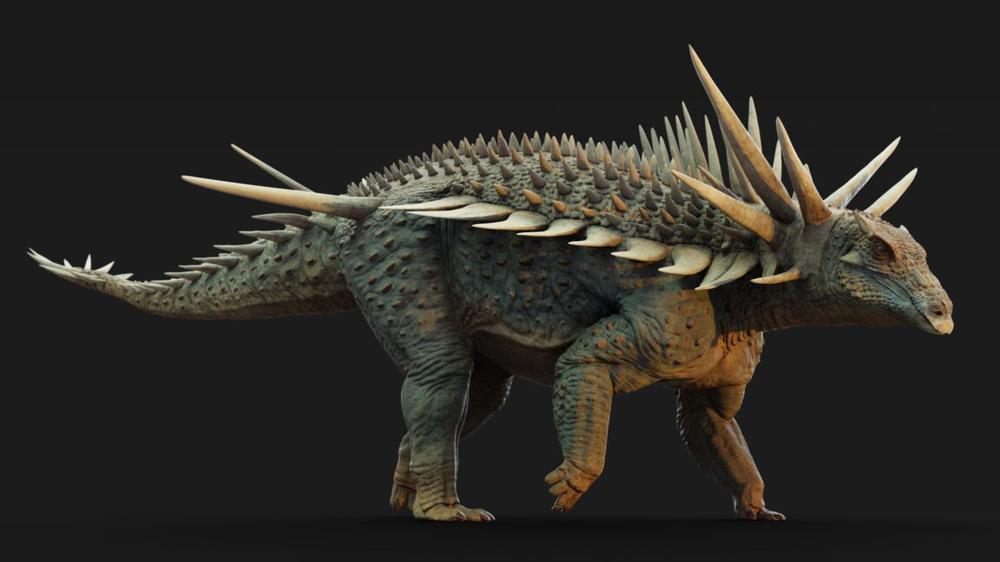Ankylosaurs, with their squat, armored bodies and bizarre, weaponized tails, are an iconic group of dinosaurs. While there were plenty of species present in the Cretaceous, they're thought to have origins that trace back to the Jurassic. It has been hard to say much about those origins, however, because the fossil evidence was so sparse. One of the earliest potential ankylosaur species, Spicomellus, was known from only a single partial rib; others are known only by jaw fragments or teeth.
Now, however, we have a much better picture of what Spicomellus afer looks like thanks to a much larger collection of bones discovered in Morocco. It turns out that the heavy armor and rows of chunky spikes found on Cretaceous ankylosaurs were actually subdued compared to the massive rows of meter-long spikes and bony collars found on Spicomellus. It looks like what would happen if you combined the aesthetics of punk with the flamboyance of glam and made a dinosaur out of the results.
A spiky find
Cretaceous ankylosaurs share a number of common features. One is a short, broad body form that kept the herbivores close to the ground when on all four limbs. Another common feature: bony plates, formed from the skin, that provided the animal with the equivalent of body armor. Some of these, especially along the animal's ribs, thickened into short, blunt spikes that provided added protection. Finally, many species had tails that ended in club-like growths that attached to the vertebrae in the tail through features with the highly technical name of "handles."
There's been some debate about the nature of all these eccentricities. One side of the argument suggests they were a protective response to the increasing number of large carnivores that evolved over the course of the Cretaceous. Others suggest that some of them were used in combat or displays that were essential for mating success. But there was general agreement that they probably evolved from simpler forms of basic protection that were likely present on the early species found in the Jurassic.
And we have known for sure that the armor was around back then, given that we've found the skin-derived osteoderms that comprise the armor in Jurassic deposits. But with little more than a rib and a handful of mouth parts to go on, it wasn't really possible to say much more than that.
Until now, that is. Because the new Spicomellus remains show extremely clearly that the armor of ankylosaurs got less elaborate over time.
The small, solid-looking spikes found along the edges of later ankylosaurs? Forget those. Spicomellus had a back that was probably bristling with sharper spines, along with far larger ones along its outer edges. Each rib appears to have generated as many as six individual spikes. At a handful of locations, these spikes extended out to nearly a meter, looking more like lances than anything needed to ward off a close-in attack.
And the largest of these were along its neck. On the upper surface of its neck, several osteoderms fused to form a massive half-collar of bone and then extended out five or more individual spikes, each among the longest on the animal's body. And there were three of these structures along the neck. "No known ankylosaur possesses any condition close to the extremely long pairs of spines on the cervical half-ring of Spicomellus," its discoverers note.
As if its hedgehog-on-acid appearance weren't enough, handles present on the tail vertebrae suggest that it also had a weaponized tail. All told, the researchers sum things up by saying, "The new specimen reveals extreme dermal armour modifications unlike those of any other vertebrate, extinct or extant, which fall far outside of the range of morphologies shown by other armoured dinosaurs."
Out go the hypotheses
Because it's so unusual, the skeleton's characteristics are difficult to place within a neat family tree of the ankylosaurs. The researchers conclude that some details of its skeleton do suggest Spicomellus groups among the ankylosaurs and conclude that it’s probably an early branch from the main lineage. But without any other significant examples from the lineage at that time, it's an extremely tentative conclusion. Still, the alternative is that this thing is unrelated to the only other organisms that share at least a few of its bizarre features, which is a difficult idea to swallow.
Assuming it is related to ankylosaurs, this throws a lot of our ideas about their evolution out the window. Since tail clubs are only present on a subset of the Cretaceous ankylosaur species, it was hypothesized that these evolved late and thus remained restricted to only some of the lineages we've found. Spicomellus suggests that these were present right from the start, so they must have been lost from many lineages.
Our ideas about the armor and spikes have their own issues. Initial hypotheses suggested those become more elaborate over time in response to the growing threat of Cretaceous predators. But now it appears that the opposite is true. The researchers who discovered the new fossil suggest that the less elaborate armor of later ankylosaurs probably was sufficient for protection, which raises the issue of why anything so bizarrely extravagant would evolve in the first place.
As you probably guessed, the answer is sex. "Structures with limited obvious functionality and that are energetically expensive to produce tend to be sexually selected and function for display or combat," the researchers argue. Their idea is that these spikes initially served both as protection and display but later shifted so that the emphasis was largely on protection.
Obviously, finding additional species from earlier in this group's history would help clarify just how much of an oddity Spicomellus was and could give us an improved picture of the trajectory of evolution of this group's distinctive features. But based on this new fossil alone, it's clear that we need to rethink a lot of things that made perfect sense based on the information we had.
Nature, 2025. DOI: 10.1038/s41586-025-09453-6 (About DOIs).

 CoD fans mourn popular skin after big Black Ops 7 carry forward change
CoD fans mourn popular skin after big Black Ops 7 carry forward change